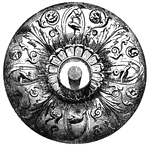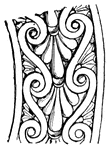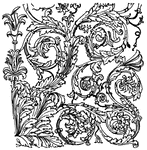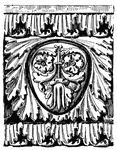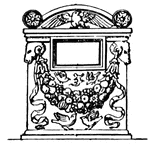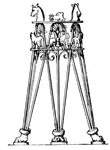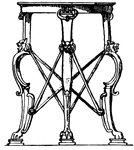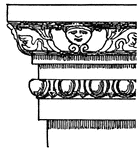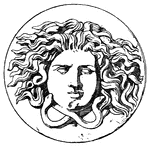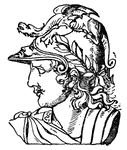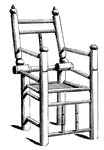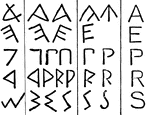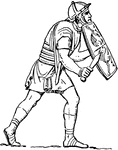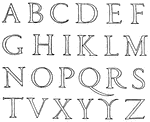
Roman Renaissance Alphabet
Roman Renaissance uppercase alphabet, 1547, specimen beek of John of Yciar, Durango, Biscaya.

Roman Renaissance Alphabet
Roman Renaissance lowercase alphabet, 1553, specimen book of Wolfgang Fugger, Nurenberg.

Cinquefoil
A five-leaved ornament, in circular and other divisions of the windows of ancient churches, and also…

Mortar Practice - Rear View
"Mortar practice- rear view of 13-inch mortar, with its usual complement of seven gunners. The mortar…

spanish caravel
A Spanish caravel. The vessels furnished by Isabella were only caravels, light coasting ships,…
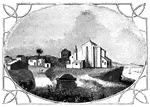
Palos
View of Palos. The pile of buildings in this view, standing upon the bluff, is the ancient Church of…

Representation of 1775
Virtual representation, 1775. 1. One String Jack, Deliver your property. 2. Begar, just so in France.…
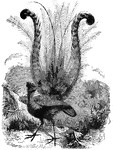
Lyre Bird
Also known as the Superb Menura, the lyre bird is noted for its distinctive tail feathers. The male…
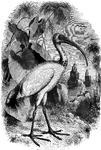
Sacred Ibis
Found throughout Africa, the sacred (or white) ibis was revered by the ancient Egyptians.
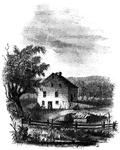
Wintermoot's Fort
Site of Wintermoot's Fort. This view is from the ancient bed of the Susquehanna, looking west. The building,…
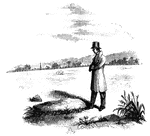
Queen Esther's Rock
Queen Esther's Rock. This view is near the ancient river bank, looking westward. The rock is a sort…
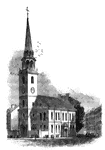
Old South
"The Old South. This venerable and venerated edifice, that stood through all the storms of the Revolution,…
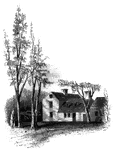
Clark's House
"Clark's House, Lexington. This building was standing when I visited Lexington in 1848. It was built…
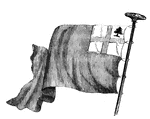
New England Flag
"The New England flag. This is copied from an old Dutch work, preserved in the library of the New York…
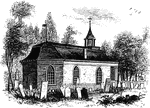
Sleepy Hollow Church
"Ancient Dutch Church in Sleepy Hollow. This view is from the church-yard, looking southwest. The porch…

Walnut Street Prison
"The Walnut Street Prison. This edifice was erected in 1774, and taken down in 1836. The beautiful new…

Monmouth Battle-Ground
"Battle-ground at Monmouth. This view is from the orchard, upon the site of Wayne's position when Monckton…
!["The Pen-Fish or Common Calamary, <em>L. vulgaris</em>, is the best-known species of the genus; the body is somewhat pellucid, of a greenish hue, changeable to dirty brown; the eyes are large and lustrous, of an emerald green, phosphoric, and fiery in a high degree. It is common in the european seas, and was known to the ancient Greeks and Romans. [Shown with a quill pen]" — Goodrich, 1859](https://etc.usf.edu/clipart/14000/14004/cmncalamari_14004_mth.gif)
Common calamari
"The Pen-Fish or Common Calamary, L. vulgaris, is the best-known species of the genus; the…

Bastile Key
"Key of the Bastile. This key of the old Paris prison known as the Bastile, was sent by La Fayette to…

Jamestown Island
"Distant view of Jamestown Island. This view is from the north side of what was once a marsh, but now…

Abacus
"A tray strewn with dust or sand, used in ancient times for calculating. A contrivance for calculating,…
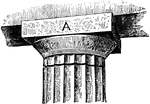
Abacus
"In architecture the slab or plinth which forms the upper member of the capital of a column or pillar,…
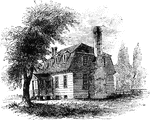
Moore's House
"This is a view from the lawn, looking south. It is a frame building with a brick foundation. At the…
